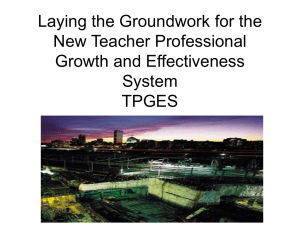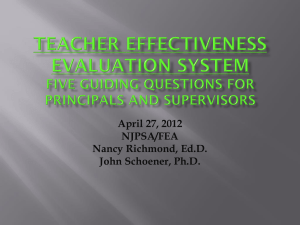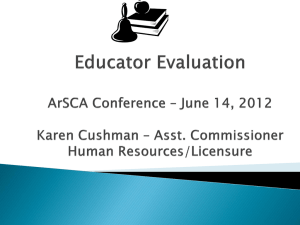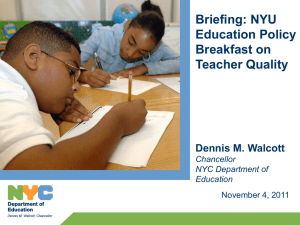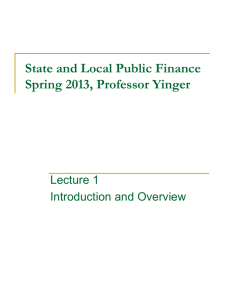Excellent Educators For New Jersey (EE4NJ)
advertisement
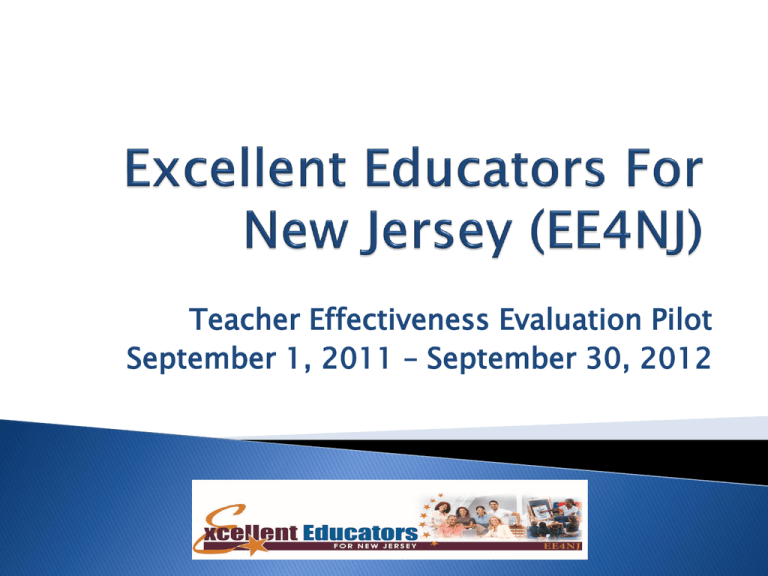
Teacher Effectiveness Evaluation Pilot September 1, 2011 – September 30, 2012 Increase student achievement Accurately assess teacher effectiveness so teachers can get meaningful feedback Support ongoing improvement of all educators ◦ Ensure appropriate training and links to professional development opportunities Facilitate school- and district-wide collaborative cultures focused on continuous improvement ◦ Foster a culture of openness and sharing Get feedback so adjustments can be made ◦ Learn about successes and challenges on a small scale first in order to design the best system possible ◦ No state-level consequences through law or regulation Actively engage district educators and stakeholders in shaping the development and implementation of the evaluation system ◦ Learn from those who will be directly affected by it Better student results from highly effective teachers ◦ Student achievement is strongly linked to teacher effectiveness Opportunity to identify and recognize greatness in the classroom and develop and support those who need help ◦ Evaluations will include multiple measures of learning outcomes and effective practice, as well as growth data State support -- $$ and resources Engaging educators and stakeholders in shaping the evaluation system and its implementation The ability to decide how to use pilot results The Notice of Grant Opportunity (NGO) for districts to apply for EE4NJ was open from 6/15– 7/28, 2011 The NJDOE received 31 applications; each application was evaluated based on quality, comprehensiveness, completeness, accuracy, and adherence to the guidelines and requirements of the NGO In order to include the widest possible distribution, the NJDOE made awards to the highest ranking application in each District Factor Group, and in each region (north, central, south) Additional awards were made based on total score based on available funds Alexandria Township (Hunterdon) Bergenfield (Bergen) Elizabeth (Union) Monroe Township (Middlesex) Ocean City (Cape May) Pemberton Township (Burlington) Red Bank Borough(Monmouth) Secaucus (Hudson) West Deptford Township (Gloucester) Woodstown-Pilesgrove Regional (Salem) All schools currently receiving School Improvement Grant (SIG) funding: ◦ Camden: Camden HS, Cramer College Preparatory Lab School, U.S. Wiggins College Preparatory Lab School ◦ East Orange: Cicely Tyson HS ◦ Essex County Vocational: West Caldwell Campus ◦ Jersey City: Fred Martin School of Performing Arts, Lincoln HS, Snyder HS ◦ Lakewood: Lakewood HS ◦ Newark: Barringer HS, Brick Avon Academy, Central High, Dayton Street, Malcolm X Shabazz HS, Newark Vocational HS, West Side HS ◦ Paterson: Dr. Frank Napier School of Technology, Number 10 ◦ Roselle Borough: Abraham Clark HS Newark Public Schools(through separate grant funding) Collaboration with NJDOE School district advisory committee Communication plan Aligned professional development plan Comprehensive training for evaluators and teachers Web-based performance management system Commitment to develop and test measures of student performance Total state funding available - $1,160, 171 Funding allocated based on the number of teachers within pilot districts ◦ $49,000-$206,000 for 25-600+ teachers ◦ Districts with less than 600 teachers: all teachers/all schools participate ◦ Districts with more than 600 teachers: may select a subset of schools to participate Any costs exceeding the grant funding amounts must be borne by the district NJDOE funding for external evaluator: $100,000 Teacher Effectiveness Evaluation System Teacher Evaluation 100% Student Achievement (outputs of learning) 50% of total evaluation Measures of Student Achievement include: • Student achievement on state- approved assessments or performancebased evaluations, representing 35%45% of the evaluation; and •State-approved school-wide performance measure, representing 5% of the evaluation. •Districts have the option of also including additional performance measures. Teacher Practice (inputs associated with learning) 50% of total evaluation Measures of Teacher Practice include: •Use of a state-approved teacher practice evaluation framework and measurement tools to collect and review evidence of teacher practice, including classroom observation as a major component, representing 25%-47.5%; and •At least one additional tool to assess teacher practice, representing 2.5%-25%. The Teacher Practice Evaluation Framework must meet the following criteria: Research-based, valid, and reliable Aligns to 2011 InTASC Model Core Teaching Standards Includes observations as major component Collects evidence on: ◦ ◦ ◦ ◦ ◦ Learning environment Instructional practice Planning and preparation Self-reflection on teacher practice Professional responsibilities and collaboration Includes rubrics with min. 4 levels of performance Teacher Practice Evaluation Framework: 25% - 47.5% At least one additional tool to assess teacher practice: 2.5% - 25% Documentation logs/portfolios Student survey Training for evaluators ◦ Minimum three days training ◦ Recommend certification or authorization for evaluators ◦ Frequent monitoring for evaluator accuracy and inter-rater reliability ◦ Ongoing coaching to ensure accuracy and inter-rater reliability Training for teachers and other nonevaluators Minimum 2 full days of training on: ◦ Standards of practice ◦ Expectations of the evaluation framework Recommended: train-the-trainer model to build district capacity and realize cost savings Non-tenured: 3 formal observations (with preand post- conference) and 2 informal observations (with feedback) Tenured: 2 formal observations(with pre- and post-conference) and 2 informal observations (with feedback) One summative evaluation with a mutually developed PDP Annual teacher self-assessment of practice Professional development to support growth Student achievement on state-approved assessments or performance-based evaluations: 35% - 45% School-wide measure of student achievement: 5% Aggregation of all students’ growth on state assessments A school- specific goal based on an area of need (e.g., graduation rates, promotion rates, college matriculation rates) Districts have the option of including additional performance measures: 0-10% Nationally normed tests, supplemental assessments, end of course tests Student achievement measure: 35-45% of evaluation Tested subjects and grades: use growth on state assessments of math and language arts in grades 4-8 Untested subjects and grades: work with DOE to identify existing assessments or develop new assessments or performance tasks Pilot districts to designate one person to oversee student achievement data The state Evaluation Pilot Advisory Committee (EPAC) will meet monthly to guide collaboration between the NJDOE and EE4NJ pilot districts ◦ EPAC members represent major stakeholder groups from a diverse cross-section of the New Jersey education landscape Each pilot district will convene a District Evaluation Pilot Advisory Committee (DEPAC) and appoint one liaison to serve on the EPAC ◦ DEPACs will include district stakeholders and will meet at least monthly to discuss pilot challenges and opportunities and provide feedback about the program By 9/30: First DEPAC meeting By 9/30: Evaluator training underway By 9/30: Update district PD Plan 10/24 (tent): EE4NJ Summit By 11/30: Begin teacher training By 12/23: Observations/evaluations underway EE4NJ Website: ◦ http://www.state.nj.us/education /EE4NJ/ Email: ◦ ee4nj@doe.state.nj.us Phone: ◦ 609-341-3306
